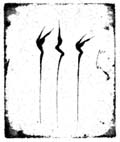4 Three ProjectsIII: The Picture Book «Fallet»1 The ideaThe inspiration for «Fallet» came as a result of a lunch time discussion I had with a friend several years back. I want to visualize what I deem as a typical attitude lots of men have towards women, namely that since there are so many pretty girls, a man can just stand there passively and one will fall into his lap. To what extent is life a tragedy in the traditional sense of the word? A saplings in the form of a women grows next to a large masculine tree. Leaves sprout. What happens to them? They fly away in the wind and we turn the pages to discover their destiny. Beauty and youth is re-warded. Ugliness is death and I’m going to be 40 years old soon. 2 Irony between pictures and wordsThe text which follows the original lunch time discussion and upon which the illustrations are based is:
However, I wanted to have an ironic relationship between the text and visual imagery. I chose instead a text which gives completely different sort of information and changes the feeling of the pictures considerably. Proverbs 3. 1 - 6:
This text was actually not ironic at all! The illustrations seemed to fit so well that there was no surprise, no irony. The total result seemed like a lament about going from the belief in a loving God to Atheism and exis-tential despair. Leaves were falling and their paths were not directed. It was kind of like a picture book version of Camus. It all seemed so depressing. Not that I think there is any thing wrong with creating a depressing book. Goethe’s The Sorrows of Young Werther is one of the most depressing books I’ve ever come across, but it is also one of my favorites. Rather, it was that I want to create things that express hope. If I couldn’t say something hopeful with out being trite, than there was not any point in the project. I worked on the book for several months and became more and more frustrated with it. Neither did it seem that I had a clear idea of what I wanted and if I knew what I wanted, I couldn’t seem to make convincing pictures of it. Finally I scanned the drawings into the computer, fiddled with them in Photo Shop and found that it gave rise to new and fruitful ideas. I read Patterns in Nature and learned about stress and flow which are principle fea-tures of photo shop filters. Art and Visual Perception by Rudolph Arnheim also helped with its chapters on balance, movement and dynamics. 3 Sometimes it helps to let things sit for a whileI put the drawings away for six months. Now at the end of the third semester, I have decided to use the conver-sation which gave me the idea of making the book in the first place, and hope that it creates an ironic relation-ship between itself, the illustrations and the title. My latest idea is this: You may be an ugly dog but your looks may get better with age. Or may be ugliness is really a protection against men with dishonorable intentions and saves young girls from unwanted teenage pregnancy. It could be a blessing to be ugly at seventeen. Those girls who fell into men’s laps and got married just after high school divorced after a short time anyway. |
